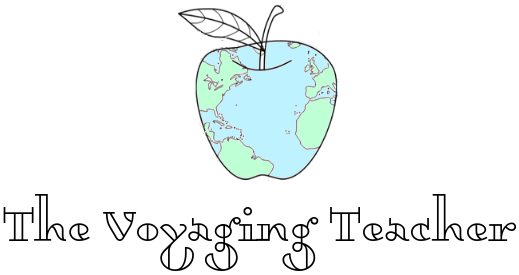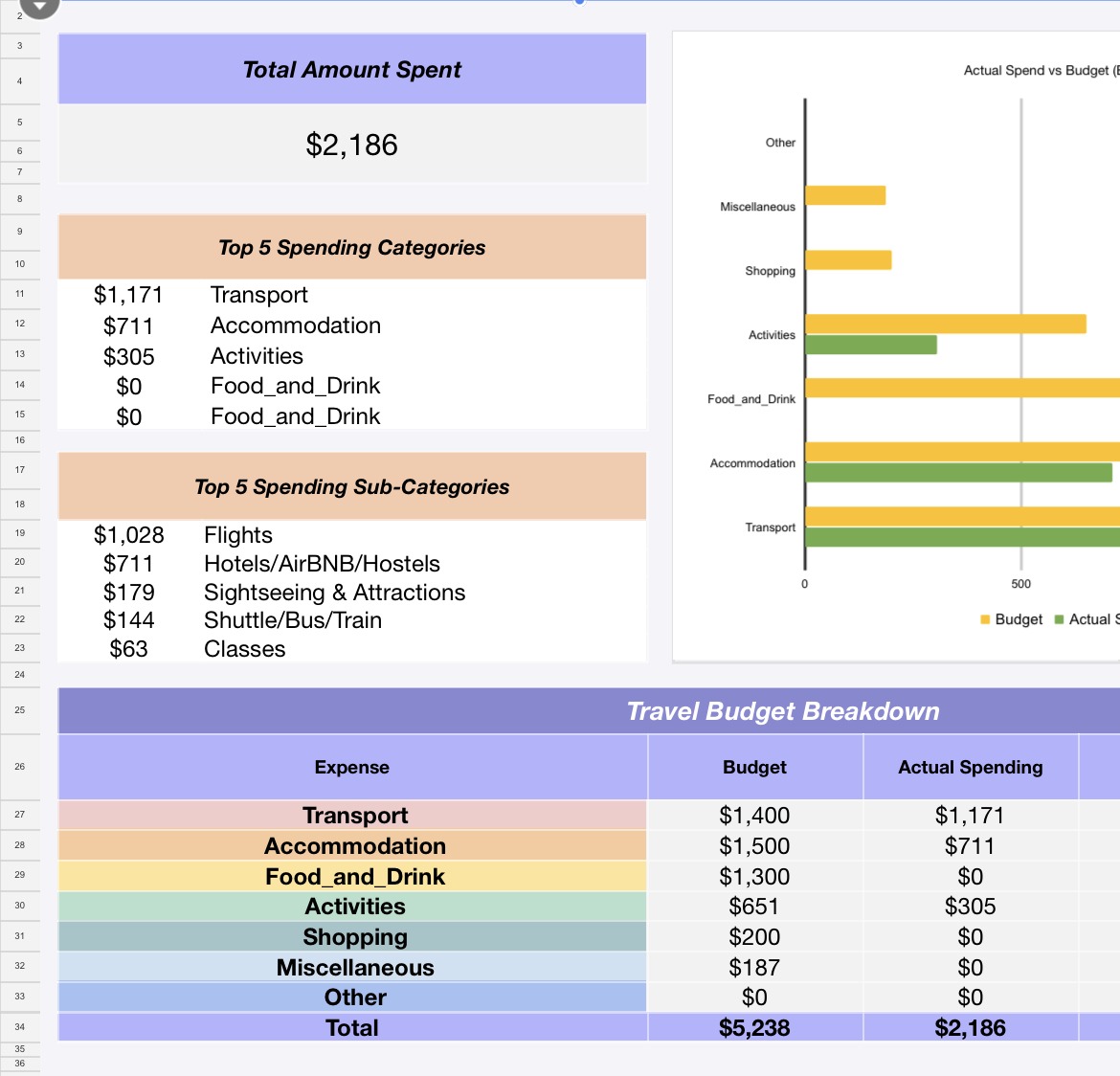Travel Budget Tips: How to Maximize Your Budget (Travel Tips for Teachers)
No one goes into teaching for the money. In fact, many teachers find travel to be difficult to achieve due to several factors including money and school schedules. Especially since most breaks line up with busy travel seasons. Often times travel seems like a luxury to teachers rather than a possibility. By following this guide for the best travel tips for teachers, you’ll discover ways to cut costs while still leaving room in your budget!
If you’re a teacher looking to travel on a budget, this guide is for you! Here I’ve compiled a collection of all of the cost saving secrets I use to travel often and on a budget!
Table of Contents
- Budgeting is Everything
- Transportation
- Accommodations
- Activities
- If you want to connect with other teachers who are trying to travel more and worry less, join the Teacher Travel Tips Facebook Group
Budgeting is Everything
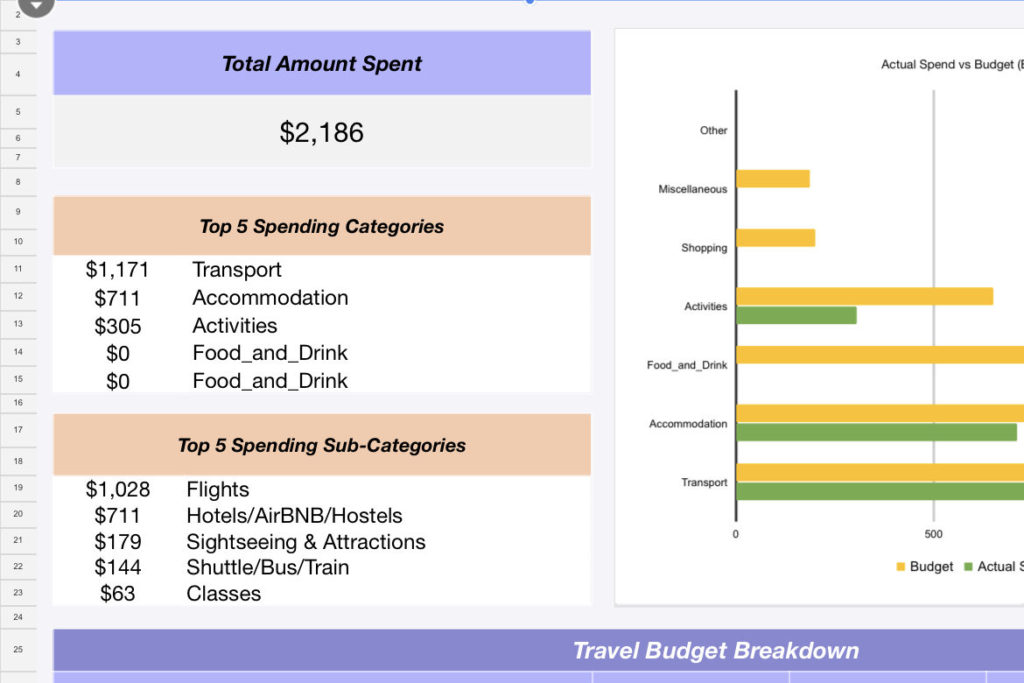
If you don’t follow anything else in this guide at least read this… budgeting is EVERYTHING. The number one tip I can give to any teacher looking to travel more is to budget and be aware of your maximum expenses and keep track of it!
I love travel and make it a goal to travel somewhere new every summer. As a teacher I am on a limited salary, so I use so many little tips to stretch my budget. First and foremost, the biggest costs are transportation and accommodations whenever you travel. By using the travel tips for teachers below, I was able to get international flights for less than $600 round trip from the US to Europe, including one $178 flight to Berlin from JFK! Accommodations were also a big concern of mine. I’m not traveling alone, however, despite traveling on a budget, none of the accommodations I’ll be using are hostel dorms or private rooms in someone’s home, except for a few days where I will be staying with friends and giving them cash or treating them to dinner to cover the costs of housing me!
Transportation
Book Smart and Book Early
As a teacher, we often know our school breaks well in advance. While school breaks are often high travel seasons, this does not mean that it is impossible to find affordable flights and accommodations. In fact, knowing your schedule ahead of time is an advantage! One of my favorite travel tips for teachers is to book smart and book early.
The best time to book flights (and accomodations!) is between 6 and 9 months ahead of time. For example, this summer I am visiting several countries in Europe to see friends and explore. My transportation costs between each country plus travel within each country cost less than $1300USD, this included trains and planes. Trans-Atlantic flights alone are traditionally $ 1000 USD or more during the summer months. Finding affordable International flights is not that difficult if you know where to look.
Secret #1: Use Skyscanner and Google Flights
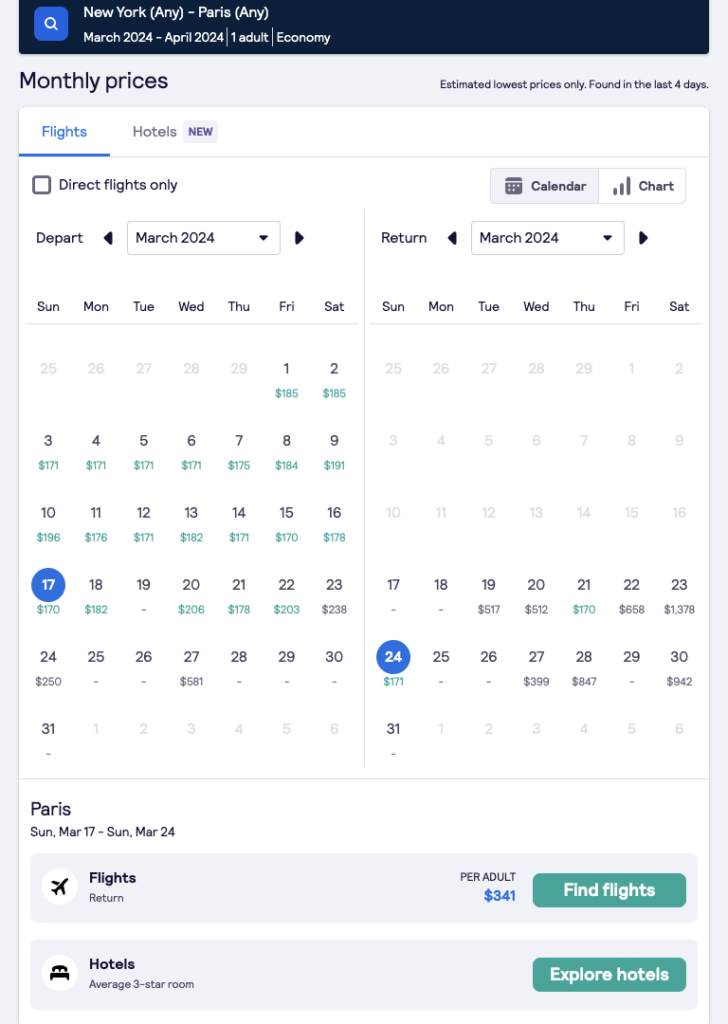
Skyscanner and Google Flights are some of the most powerful engines out there for travelers to find affordable flights. Of the two, I prefer Skyscanner because it provides users with better searches, including calendars, and the visual representation it provides of high travel cost days. Using Skyscanner, I could book a one-way flight to Amsterdam for only $178 USD in November for a trip in July.
Skyscanner and Google Flights also have a feature where you can view the flight costs for anywhere in the world. If you have no specific destination in mind this can be an easy way to discover a destination that is both affordable and of interest. I almost exclusively use Skyscanner to find flights because of how well it consolidates flight information. One of the only issues with Skyscanner is that the price it shows is typically from 3rd party sites
Secret #2: Fly Out of Major Hubs
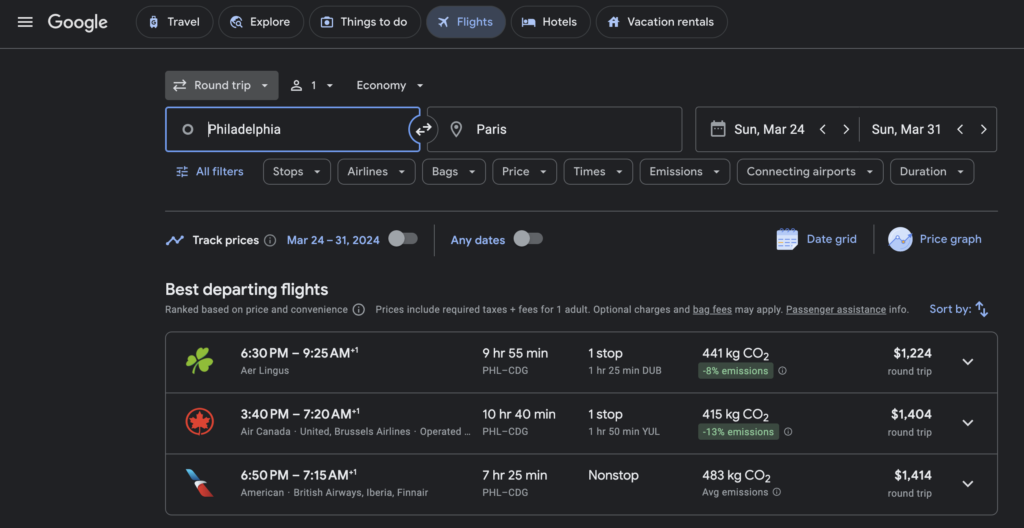
I live in the Philadelphia area and while the Philadelphia International Airport (PHL) is a fantastic airport for many domestic flights, it costs more for International flights. However, Philly is a short distance from John F. Kennedy Airport in New York City, where more affordable International flights can be found. The cost of travel between the two cities is nominal, with an average cost of $30 on Amtrak both ways. Some airlines, like EVA Airline out of Taiwan, even provide free airport shuttles between the cities.
The difference between flying out of one city and another could be enough to save you thousands on your flight. For those on the east coast of the United States, there are hubs that can save you thousands on flights, including John F. Kennedy (JFK) and Charlotte Douglas (CLT). However, hubs are located throughout the United States and are accessible to millions of travelers a year.
Secret #3: Timing is Everything for Teachers
The best way to save money is to book ahead of time. Luckily, our schedules allow us to make minor adjustments when we fly while other industries have schedules that are tied to approved time off. If you’re able to, be more flexible you are with your itinerary and schedule. Use your schedule to your advantage, because if I can’t give you any other travel tip as a teacher, it would be to be proactive and use the advance notice of your schedule to find deals!
Flying out on a Tuesday or Sunday is usually more affordable than any other day of the week. Fortunately, teacher schedules are set so far ahead of time that moving the flight days can be done easily. I typically know my last day of work at the beginning of the year, so I can plan accordingly. I’ll typically buy my tickets for my trips around 6 months out as it’s the sweet spot for travelers.
Apps like Hopper have alerts that you can set up that allow you to set price drop notices for your flight dates to aid in booking as well!
Secret #4: Shop Around Different Airlines
Brand loyalty is a real thing, even when it comes to flying! Many airlines have credit cards that offer Airline miles and this can be really useful if your preferred airline flies to your destination. However, one of the best ways to save money is to shop around different airlines for deals. The same direct route from Amsterdam to the USA might be $2000 with American Airlines, but only $600 with Aer Lingus.
Skyscanner and Google Flights make shopping for flights easier, but they also show third-party website prices. While it might be slightly more expensive, book directly with the airlines, instead of third parties like Expedia, to ensure your tickets will not be canceled or affected. Third parties are not liable for any cancellations. Typically, booking direct only costs around $50 more for peace of mind.
Skiplagged is also a great way to find flights as it scrubs the internet for hidden city flights where your final destination may be a layover to another city. For example, I took a flight from Alabama to Philadelphia on a flight plan for Birmingham to Boston with a layover in Philadelphia. It was cheaper to use Skiplagged than to book direct to Philadelphia. One downside of Skiplagging is that checking bags is not possible as bags are connected through to your final destination. Please note that some airlines are trying to cut down on Skiplaggers so use with caution.
Pack Light and With Purpose
The more you pack the more difficult it makes everything else. I should know, I used to be a chronic overpacker and all it did was make everything else more difficult. When I went to Taiwan I took my largest suitcase and a backpack for two weeks, I ended up coming home with another suitcase and carry on bag, way too much for one person to manage. Since then I’ve found the beauty in traveling light with only a personal item size bag.
Secret #1: Fly Carryon or Personal Size Only
Anyone who has traveled extensively will tell you that the more you bring the more you have to worry about. This is especially true for places like the EU due to the streets being primarily cobblestone or steep. If I had known this in 2017 when I took my first trip, perhaps I wouldn’t have had to carry so many bags with me everywhere!
There is beauty in traveling carry on or personal size only. While flying personal size only may seem terrifying to someone who over packs, it’s liberating to only have to worry about a backpack. For one, if you’re visiting the EU and plan on taking any flights between countries, many of the operators are budget and charge extra for larger bags. Airlines like EasyJet and Ryan Air are notorious for baggage fees and their size requirements.
For airlines like EasyJet and Ryan Air, their size requirements are 45 x 36 x 20 cm (18 x 14 x 8 in) which is a maximum litre amount of 32.5. I suggest going for a bag that doesn’t have a lot of bulk but is durable, like a camping backpack. A good option is looking for a waterproof camping backpack like this one from Amazon. If you prefer a duffle bag, I would suggest this one from Amazon, as it is compact.
As teachers, traveling with a carryon will save so much money and ensure you spend more time traveling and less time wasting money on baggage fees. The purpose of sharing travel tips for teachers is to save you money, even if it seems like there’s drawbacks like traveling with smaller bags.
Secret #2: Compression Packing Cubes
Say it with me, compression packing cubes are my friends. Ever since my first time using my compression packing cubes, I was hooked. Compression packing cubes can save so much space in your bag and provide useful organization for your clothes.
There are two types of compression cubes, fabric compression and rolling plastic compression bags. While I’ve used both, the plastic ones save more space but the fabric ones are more durable and breathable. Fabric compression cubes use a two zippered system, one to close and one to compress. I’m not a small woman by any means, however, I can easily fit a weeks worth or more of clothes into a few packing cubes and still have space for an extra pair of shoes or on return a large bag of Mardi Gras beads (true story) without overfilling my bag.
Secret #3: Do Laundry
I know, I know, when I think vacation, I don’t think: LAUNDRY YAY! However, by doing laundry on your trip, you can save by packing a smaller bag. Most backpackers will book accommodations with laundry facilities, however, there are many affordable laundrettes available internationally. If you don’t have access to a laundry facility, I’d suggest packing either these travel size laundry sheets or these larger ones (that I use at my own home as well!) and using your sink!
A travel clothes line is also a worthy investment as it can help you dry your clothes faster than laying them out wherever your accommodation is as dryers are not a guarantee. By spending an hour or two washing clothes and hanging them up to dry, you’ll save time and sanity.
Secret #4: Be Purposeful with Your clothing Choices

One of my favorite packing tips is: lay out everything you want to bring on your trip to wear and then bring only half. When we pack we have ideas of what outfits are a must for different destination. Trust me, I have a dress that I bought specifically for my upcoming Europe trip and I now have to consider how to fit it into my bag with everything else I want to bring.
The best thing you can do to pack is to pack a capsule wardrobe of sorts with complimentary pieces. If you ask any of my students, you’d hear that I am fashionably challenged. However, I am better at packing clothes for my trips that are both cute and complimentary. While most bloggers will recommend to chose items that are neutral tones, there’s nothing wrong with a bit of color and patterns as long as your clothing is complementary and can be mixed and matched.
Some fabrics are bulkier than others. Fabrics to avoid are denim, polyester, and fleece (unless you plan on traveling in the winter). While polyester isn’t bulky, it’s not always breathable either and can be more difficult to wear during the summer months. Fleeces and sweaters are bulkier but also a necessity in the winter. You can avoid over packing and taking up too much space with these by packing with layers in mind.
Good fabrics to pack are definitely linen, cotton, modal, and viscose. These fabrics are not only breathable but also relatively space efficient. I avoid jeans and jean shorts because of how bulky they are (even if they’re cute!). I prefer to opt for pieces made from linen or viscose because they are easier to pack and are more breathable.
Bonus Tip: Rolling your clothes instead of folding them while packing will also significantly improve how much space you have in your bag! The tighter the roll the more space you’ll have available. The more clothing the less laundry! | Travel tips for Teachers
Secret #5: be wise with personal Care items
When flying carry on and personal item only, there is a limit on how much liquid you can bring on a plane. The general rule for flights is 3-1-1 (3.4oz/100ml, 1 litre/quart, 1 bag per person). 1 quart of liquids is not a ton of space and can seem a bit difficult to manage when on long trips. There are several workarounds that I’ve found to be useful.
One of the workarounds that I’ve found as a woman who enjoys wearing makeup while traveling is to subscribe to services like Ipsy for a few months prior to my trip in order to collect a decent amount of deluxe sample sizes of make up products. By using sample sizes versus full size or even travel size products I’m able to slowly clear up space in my bags by using the products and then discarding the empty bottles once they’re done. I can easily make a bit more space for a souvenir or two throughout the trip.
Another option is to use products that have multiple purposes. For example, I use a foundation that has a high SPF rating and also UV protection. The foundation comes in a compact versus a bottle so it does also save a bit of space. Other suggestions would be to utilize Alleyoops make up products as they have a ton of space saving options for make up products. My new favorite travel accessory their 4 in 1 Brush, the Multitasker, as it condenses all of the things I already use when doing my makeup into one to save space.
Accommodations
Don’t Settle
When you first start doing research on your destination, you might book the first affordable accommodation you can find because who knows what will happen if you wait to long! However, sometimes settling on a place to stay can actually prevent you from finding better options elsewhere.
Secret #1: Shop Around Different Sites
Like airlines, many travelers have loyalties to different hotel chains. However, just because you have loyalty to a specific hotel chain doesn’t mean that it’s the most affordable to you as a traveler.
There are many types of accommodations including hotels, hostels, Airbnbs, homestays, work away, house-sitting, and more. Airbnb and hostels are the most affordable options for private rooms. Websites like Booking.com may seem suspicious in the USA. However, in Europe, they’re known to be very reliable and provide affordable accommodations. For a month in Europe, we spent roughly $1400 USD on accommodations, including Airbnbs and hotels, for an average of $46 a night. The benefit of Airbnbs is access to full kitchens and private spaces, especially if traveling in a larger group.
I also do not see any issues with booking private rooms in Airbnbs to save a bit of money. When I went to South Korea for three weeks, I booked a women’s only accommodation in Hongdae for only $490 for the whole trip! The owner even went on holiday while I was there essentially giving me a private homestay!
Secret #2: Use Home Sharing Sites
There are several less popular options for travel that can be just as enjoyable like Couchsurfers, Trusted Housesitters and other sites! These sites provide low cost or free housing typically in exchange for a service. In the case of sites like Couchsurfers that community typically expects reciprocation. Other sites like trusted housesitters your either exchanging your home with someone else or taking care of a pet while the owner is out of town. This can be an affordable way to travel, however, there is a bit of risk involved with this type of site due to the requirements.
Secret #3: Hostels? But what about that one movie?
The first time I stayed in a hostel, my parents were convinced that I was going to get murdered or worse. However, hostels are actually one of my favorite ways to travel because I can get an affordable private room without compromising on my budget. The last time I stayed in a hostel in New Orleans, we spent roughly $220 per person for a private room with ensuite for five nights! Comparatively, a hotel in the same city would’ve cost around $600-800 more overall.
Hostels are an incredibly affordable way to afford accommodations. One of the best parts is that you can choose rooms based on your comfort level. While they are basic hotels with typically just sheets, a towel, and pillow provided, they are very cheap options with not only group dorms, but also private rooms with private bathrooms as well! Because of how cost effective they are, hostels attract people of all ages and occupations.
When traveling as a woman, you can also elect to have a private room and pay significantly less for accommodations versus a traditional hotel. If you want to save even more money, the dorms are a great option with many costing less than $30 a night for a bed. You do have to provide your own lock for a personal locker but this is still not a terrible option when you want to travel more affordably as a teacher.
Activities
Do Your Research and Book Activities Early
2023 is set to be one of the busiest travel years of the past decade. Due to this, many popular attractions are selling out quickly. Booking early prevents having to wait in lines, especially when you’re short on time and want to save money. A lot of attractions have limited tickets available for advance purchase with third party tour sites, like Viator and Get Your Guide, having the opportunity to buy tickets separately and sell at a premium. I’ve used both Viator and Get Your Guide in the past and both are reliable ways to find tickets for popular spots.
Secret #1: Set Reminders for Buying Tickets
A lot of attractions only release tickets for popular attractions, like the Colosseum and the Paris Catacombs, a week to a month early. The more popular the attraction, the more competition for tickets. I’ve found the best way to ensure I get the most affordable ticket prices is to set reminders on my phone for the date and time tickets go on sale. Tickets for attractions like the Eiffel Tower sell out almost immediately while tickets for sites like the Conciergerie in Paris are less likely to sell quickly. The Vatican and the Colosseum are almost as cutthroat as those for the Eiffel Tower, so setting these reminders improves individual chances to visit UNESCO sites.
Secret #2: Find Free Tours and Attractions
In almost every destination there are free walking tours done by locals. The easiest way to find this is to google your desired destination and free tours. You should be able to see this on Google Maps as well. Often these are offered by tour companies to entice visitors to book their other tours. These are typically pay what you wish and the tour guides appreciate tips.
There are dozens of attractions that cost no money. For example, Pere Lachaise Cemetery in Paris is home to the graves of many famous authors and musicians. However, it is free for all to visit. In many countries, some of the most popular attractions are free because they are landmarks like Times Square or National Park sites like Independence Hall.
Secret #3: Take the Road Less Traveled
There are so many amazing opportunities to explore new places than just visiting the popular attractions. I highly suggest visiting the website Atlas Obscura to find unique attractions at your destination. Through Atlas Obscura, I’ve found several hidden gems that I am so happy I found including Martini Junction and 59 Rivoli, both of which are incredibly unique and free!
Book Travel Insurance
While many people see travel insurance as an uneccessarry expense, travel insurance is one of the most important things you absolutely cannot skip purchasing when traveling abroad. While healthcare is less expensive abroad in many cases, having travel insurance allows you to have peace of mind while traveling. There are several companies that offer travel insurance with the most affordable and comprehensive options being offered by WorldNomads and Allianz. I have used Allianz several times with no issues.
At its core, travel insurance is basically insurance that covers anything from travel delays and lost luggage to broken bones and accidental death. Some credit card companies also offer this as a perk when you sign up for their cards.
While this may seem like a purchase that can be foregone, costs of even getting a cast in some countries can be in the hundreds. If you don’t follow any other travel tips for teachers, protect yourself with travel insurance.
